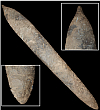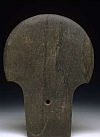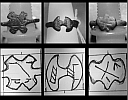|
See these, and more, in this issue of the Central States Archaeological Societies Journal

Click to enlarge |
An incredible Dover Sword that measures a massive 16 inches in length. It was previously collected by John
Waggoner and Dan Stroud. It was uncovered in Stewart County, Tennessee. Many other Dover Swords have been found
in the same county, as well as in Montgomery, Humphreys, Warren, Davidson and Sumner Counties. One sword in the
Ron Knight collection measures an incredible 24 ¼ inches (see pages 100-101 in this issue) and one in the Duck River
cache measures an amazing 28 inches in length. These swords are masterpieces of prehistoric craftsmanship, requiring an
immense nodule for the prehistoric knapper to work from.They most probably were made at the Dover Quarry, where
evidence of a massive prehistoric flint knapping operation has been uncovered. Swords, knives, spades and other objects
were crafted on site (see Prehistoric Lithic Industry at Dover, Tennessee by Richard M. Gramly). Dover swords had wide
distribution throughout the south and Midwest including many examples at Etowah as well as more than 60 broken
swords found during the WPA excavations at Spiro. These date to around the early fourteenth century.
Collection of Michael Sedler, Lawrenceburg, Indiana
Photography by Steven R. Cooper |

Click to enlarge |
It was the summer of 2016, and Scott Sprague was hunting the stream on his property. Scott Sprague lives in the country Union County, just northeast of Columbus, Ohio, and likes looking for rocks and odd things of interest. Scott Sprague found 2000 year old Hopewell ceremonial pipe, most likely broken intentionally after being used. Note the earspool at the left at the back of the head and the stem hole at the front.
See: The Pipe by Scott Sprague and Steven R. Cooper page 116 April 2017 Journal |

Click to enlarge
|
Short pole spatulate celt, Kogers Island site (1Lu92) (A.D. 1350-1450), Lauderdale County, Alabama. Courtesy of the Office of Archaeological Research, University of Alabama. photograph by David H. Dy
See: Mississippian Ritual Weaponry by David H. Dye, University of Memphis
page 122 April 2017 Journal |

Click to enlarge |
The three Jesuit Rings. Shown are a photograph and a line drawing of each to highlight the details and to show precisely the engraving on each. Ring # 769 is at the far left Circa: 1700-1789. Found about two miles west of Fort Michillimackinaw, near McGulpin Point in northwest Emmet Co., Michigan. In very close proximity, about two feet away, Jesuit ring, # 775 was located.; Ring 775 is at the center, Circa: 1700-1789. Found about two miles west of Fort Michillimackinaw, near McGulpin Point in northwest Emmet Co., Michigan. Was found within two feet of Jesuit ring, # 769.; and Ring # 791 is at the far right.
Circa: 1700-1789. Found about two miles southwest of Fort Michillimackinaw and about one mile south of the above two, in northwest Emmet Co., Michigan.
See: A Case For Native American Altered Jesuit Rings
by
Jake Ilko Jr.
page 109 April 2017 Journal |
HOME
|
|




